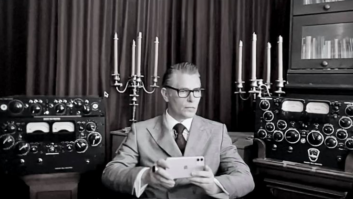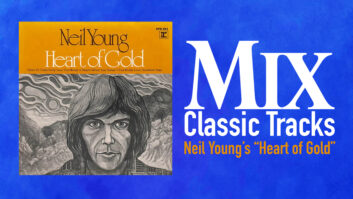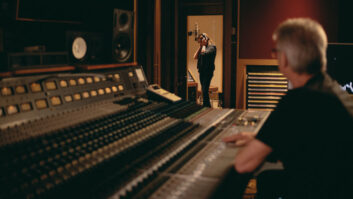Remember the saying, “You sound like a broken record”? You used it when you wanted to shut someone up who was saying the same thing over and over again. Its origin, of course, is from the (first) days of vinyl: When the stylus encountered a crack, a scratch or a piece of dirt, it would get knocked into the previous groove, so the same little bit of music would play forever. Today, of course, that would be considered an artistic choice, but in the days when the preferred mode of music playback was strictly linear, it was highly annoying.
Ironically, nothing sounds more like a broken record these days than the record industry itself. Like a needle stuck in a particularly irksome groove, the major labels are once again howling that record sales are being killed by piracy. If it all sounds very familiar, it’s because we’ve been here often: When analog cassettes became a major delivery medium (thanks in large part to Henry Kloss — see below), when DAT machines were struggling their way onto the market (and failing) and when Napster was getting a million hits a minute, the record companies were making the same dire prediction.
This is not to deny that something is going wrong in the record biz. The revenues of the five major labels that control the RIAA (and it recently almost became four, but for reasons that are about to become obvious, nobody seemed to be interested in buying EMI) were off last year, for the first time in a long time. But to put the entire blame on piracy ignores the fact that we really did have a recession, particularly in the music-loving high-tech sector; plus, we were targets of terrorist attacks, both real and imagined, which put a severe damper on commerce in general, especially of the leisure kind.
And let’s not forget that minor accounting problem EMI had when it sacked Mariah Carey: Barely nine months after giving her the fattest recording contract in history, it bought her out, taking a $49 million hit. Then, it cut 1,800 jobs to cover it and announced it was pulling its stake out of music retailer HMV. You gotta love this business.
Armed with dubious surveys that point to billions of dollars being lost because of teenagers downloading Limp Bizkit tracks from Napster and its more lawsuit-proof descendants Kazaa and Gnutella, the music conglomerates late last year took a bold step toward protecting their bottom line by introducing a new business paradigm: They started to put out — you knew this was coming, right? — broken records.
Several million compact discs have been issued with some kind of “protection” designed to prevent their audio from being extracted by computer CD-ROM drives. Four companies have developed copy-protection technologies for audio CDs, and some of them are very clever, but they all share some rather serious problems. One is that the discs don’t seem to work on a fairly significant number of audio CD and DVD players, as well as Sony Playstations. Another is that a lot of computer drives, especially DVD-ROMs, have no trouble reading them. And a third is that according to the folks who own the trademark, these discs are no longer CDs.
Most of the action so far in this brave new world of musical copy-proofing has been in Europe. A spokesperson for one developer, Midbar Tech, which is based in Israel, says that this is because European nations are ahead of the United States in terms of both writing copyright laws and enforcing them — and in terms of the incidence of piracy. Something like 15 million of the discs have found their way into stores so far. Avex, Japan’s largest indie label, recently signed on as the first label in that country to use protection, while in the States, as I write, there are only two encoded CDs available: the soundtrack from the movie The Fast and the Furious and Charley Pride’s Tribute to Jim Reeves. The former uses Midbar’s Cactus Data Shield, and the latter uses MediaCloq technology from Phoenix-based SunnComm. Another developer is Macrovision, whom you may remember from its vertical-drive-suppressing copy-protection system for videotapes.
So how do they work? Well, they can’t suppress a sync signal on an audio CD, because there ain’t none — PCM digital audio is self-clocking. Nor can they notch out a piece of the audio spectrum, the way some old and unsuccessful systems tried to do, because that would be painfully audible and consumers wouldn’t stand for it. And they can’t take advantage of the SCMS-bit idea that killed the domestic DAT market, because there are far too many computers out there that wouldn’t know a SCMS bit if it (pardon the expression) bit them on the ATA.
The systems use one or more of three basic techniques. One, they deliberately put errors in the audio data, based on the idea that audio players, with their relatively robust error correction, are much more tolerant of media errors than data drives are. Two, they scramble the directory and the header (.cda) files so that the computer looking to rip the audio can’t find the tracks. Three, they put non-audio data tracks on what are supposed to be audio discs, with the idea that computers will glom onto the data tracks and not see the audio tracks. One radio engineer reports that on a Michael Jackson promo CD released to stations last September: “The TOC tells a Windows PC that the disc has a Multisession/Hybrid CD-ROM portion. But that section of the disc is either corrupted or has a piece of code that the computer can’t read. And so the CD just spins in the drive.”
The SunnComm system goes further: If you try to extract the audio from it, it makes your computer go online to the label’s site, where you can purchase a license to download the song you’re trying to hear! So, buying it once on CD apparently isn’t enough: If you want to make a dub of it, you’re going to have to pay twice.
One thing all these schemes have in common is that they have made Philips, which co-owns the Compact Disc patent with Sony, absolutely furious. Philips is telling those who do this to a CD that they may not print the “Compact Disc” logo on it, because it doesn’t conform to their specs — it’s broken. Meanwhile, Philips (which, until recently, owned PolyGram Records) is also saying that its next generation of CD burners will be able to both read and write all of the protected formats, which means no one’s protected CDs will be very protected.
Another concern of Philips’, and many others, is that pressing a CD that contains deliberate errors will shorten its life span. Yes, CD players have error-correction, but they are designed to deal with ordinary wear and the occasional scratch or piece of dirt. If the system is already working hard to play a new, clean disc, it may take very few additional errors caused by normal problems before the disc becomes unplayable.
Do these schemes work? Sort of. Not being able to pass up a challenge, hackers all over the world have been trying to break them since the first protected discs came out, and they’ve managed to do just that, generally without much trouble. One journalist found that an ordinary computer DVD drive couldn’t see the copy-protection files on The Fast and the Furious disc, but it could see (and therefore rip) the audio tracks just fine — except for the first track, which refused to play under any circumstance. An English engineer analyzing the Charley Pride disc found at first that the files would rip with a plain old CD-ROM drive, but there would be significant errors in the resulting .WAV files. But when he listened closely to the disc, he found all sorts of problems with the sound, including non-random clicks and an almost total lack of stereo separation. Eventually, he did find a program called “X-tractor” that could copy the audio “with what sounded like perfect quality to my ears.”
So, if the hacker community can get past any of these systems, why do the labels bother? According to Marjie Hadad of Midbar Tech, “The point of the exercise is to keep honest people honest. We can put a dent in copying. There is no such thing as 100 percent protection, but we do our best to keep one or two steps ahead of the hackers. We make it a moving target, so there’s no ‘universal hack.’ We’re using multilevel protection — they might be able to get through one level, but it’s unlikely they’d get through all of them.”
It’s hard to keep secrets, however, in the age of the Internet, and it’s easy to search the Web and find the right application, or the right procedure, to get past the protection on any CD. While it may not do much for the record companies, it all leads to, as my editor says, lifetime job security for hackers.
But copy protection is only part of the labels’ strategy to keep people from copying their discs. They’re also looking to new legislation. The 1998 Digital Millennium Copyright Act (DMCA), perhaps the most big-corporation-friendly, small-guy-screwing intellectual-property law in U.S. history, made it illegal to make or sell any device that could circumvent copy-protected works. It’s an absurd law in that it means that any DVD player that just happens to be able to ignore the copy protection on any particular audio CD is in the same category as black-market cable TV descramblers. It would also outlaw video timebase correctors, thereby putting a total halt on television production everywhere on the grounds that these rather crucial components can also be used to copy Macrovision-encoded videotapes. Philips’ new CD burners would, of course, be banned instantly. One congressman, Rick Boucher, R.-Va., has been trying to get the clause repealed, but he faces an uphill battle. More hopeful is that, as I write this, a federal judge is hearing final arguments that it is unconstitutional.
But there could be more to come: South Carolina Senator Fritz Hollings has proposed something called the Consumer Broadband and Television Promotion Act (don’t you love the names of these things?) that would prohibit creating, selling or distributing “any interactive digital device that does not include and utilize certified security technologies.” In other words, your computer, DVD player, game machine, television, cell phone and clock radio will all be required to have firmware that tells them when they’re allowed to read a file and when they’re not. Fortunately, this bill won’t be going anywhere soon, thanks to the efforts of Vermont Senator (and well-known Grateful Dead fan) Patrick Leahy, who chairs the Judiciary Committee.
In another column, I’ll talk about some ideas on how the record companies can get the most out of their assets — without stomping on your rights and mine, and without sounding like a broken record.
…
The world of audio mourns the loss of two giants, both from New England. David Blackmer, founder of dbx and Earthworks Audio, passed away on March 21, in New Hampshire, at the age of 74. George Petersen’s appreciation of him appeared in last month’s issue and can be found on mixonline.com.
On January 31, in Cambridge, Mass., inventor and entrepreneur Henry Kloss died at age 73. For over 40 years, Kloss (pronounced “close,” as in “near”) was one of the most important figures in the world of consumer audio — what we used to call “hi-fi.”
In the gear I’ve collected over the years, I can find almost every generation of Kloss-designed products. There is a speaker by Acoustic Research, the company he co-founded in 1954, which produced the first acoustic-supension speaker system so that listeners could hear decent bass without a box the size of a refrigerator in their living room.
There are speakers by KLH, which he co-founded, that lived in several of my college dorm rooms. The other room where I spent all my time in college, the electronic music lab, also had KLH speakers, four big ones. And when I moved into my first apartment, my roommate had a KLH Model Eleven, the first “suitcase” stereo system, whose low price, good sound and ruggedness helped millions of folks participate in the musical explosion of the ’60s. KLH also made a hi-fi table radio, which introduced many to the world of FM, and the very first product to incorporate Dolby B noise reduction: a reel-to-reel tape recorder.
There are Advent products (including the speakers that I bought for my father) that were also used as monitors in the first two classical radio stations where I worked; the cassette deck, which Kloss created by installing a Dolby B circuit into a Nakamichi transport, instantly bringing what had been a lowly dictation medium into the realm of high fidelity, where it has lasted for over 30 years; and the NovaBeam television projection system, which, although it was a commercial failure (among other problems, the video sources of the day looked pretty awful when they were magnified that much), won an Emmy Award and paved the way for the ubiquitous home theaters of today.
Finally, there are Cambridge Soundworks systems, the pioneering tiny-speakers-with-external-woofers design that millions of computers (including two of my own) are now plugged into, which have raised thousands of listeners’ consciousnesses about surround sound.
Henry Kloss wasn’t a “pro audio” guy, but without his contributions and the audience they created, very few of us would be doing what we’re doing.
Paul Lehrman is the original, and not duplicatable. Read his previous Mix columns atwww.insideraudio.com.







